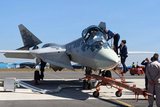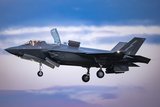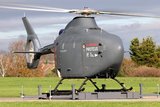Bulgaria’s first F-16 Block 70 takes flight
The F-16V is currently operated by 27 countries, with six countries selecting the F-16 Block 70/72 version for their fleets. (Photo: Lockheed Martin)
Lockheed Martin has announced the successful flight of the first Bulgarian F-16 Block 70 aircraft. The flight took place on 22 October at its production facility in Greenville, South Carolina. Multiple system tests to validate the aircraft’s performance and supersonic capabilities were carried out during the flight, Lockheed confirmed.
In 2019, Bulgaria first signed a Letter of Acceptance (LOA) for eight F-16s, and a second LOA for an additional eight jets in 2022. The F-16s will reportedly replace the Air Force’s ageing Soviet-era MiG-29s. Block 70 is the latest version of Lockheed’s F-16 design and features advances avionics, an APG-83 radar and a modernised cockpit with new safety features.
OJ Sanchez, VP and general manager for the Integrated Fighter Group at Lockheed Martin said: “With the F-16 Block 70, the Bulgarian Air Force will be well-equipped to secure its borders and partner with US, European and NATO allies.”
According to Shephard Defence Insight, the procurement cost for eight aircraft has been calculated to be around US$500 million. However, the $1.3 billion deal made with the government includes the aircraft, along with related equipment, weapons, raining and logistics support.
As noted by the Bulgarian Ministry of Defence, the first batch of eight F-16s are anticipated to be delivered in 2025. The second batch of eight F-16s will follow in 2027. Bulgaria will become the second European country to receive the F-16 Block 70 aircraft.
According to Bulgarian Military, however, this jet – and a second jet – will remain stationed in the US to be used as training platforms for incoming Bulgarian pilots.
Related Programmes in Defence Insight
Related Equipment in Defence Insight
More from Air Warfare
-
![Northrop Grumman to fly new Project Talon CCA by late 2026]()
Northrop Grumman to fly new Project Talon CCA by late 2026
The newly unveiled collaborative combat aircraft looks to strike a balance between capability and cost-effectiveness, according to the company.
-
![MBDA and Lockheed move closer to F-35A Meteor flight tests]()
MBDA and Lockheed move closer to F-35A Meteor flight tests
Following the completion of successful ground tests, one more exercise remains before flight testing can begin.
-
![Leonardo’s Proteus concludes ground tests with maiden flight on horizon]()
Leonardo’s Proteus concludes ground tests with maiden flight on horizon
The technology demonstrator forms part of a wider effort to help the Royal Navy explore the potential of uncrewed systems supporting its existing crewed aviation platforms.
-
![Airbus MQ-72C Lakota Connector progress on track ahead of pending USMC decision]()
Airbus MQ-72C Lakota Connector progress on track ahead of pending USMC decision
The MQ-7C uncrewed aircraft is currently undergoing further internal flight tests ahead of a government test event anticipated for next year.






















